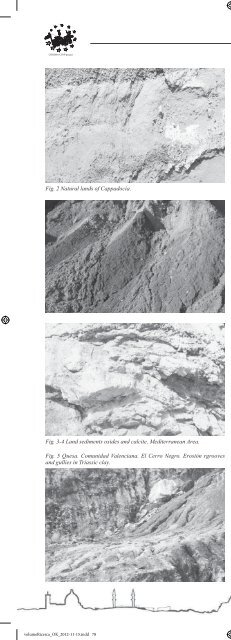habitat rupestre.pdf - Società Friulana di Archeologia
habitat rupestre.pdf - Società Friulana di Archeologia
habitat rupestre.pdf - Società Friulana di Archeologia
Create successful ePaper yourself
Turn your PDF publications into a flip-book with our unique Google optimized e-Paper software.
THE NATURE OF COLOURCRHIMA-CINP projectFig. 2 Natural lands of Cappadocia.Fig. 3-4 Land se<strong>di</strong>ments oxides and calcite. Me<strong>di</strong>terranean Area.Fig. 5 Quesa. Comunidad Valenciana. El Cerro Negro. Erosión rgroovesand gullies in Triassic clay.to the layers of soil at the surface. Thanks to this phenomenonwe can appreciate the varieties which <strong>di</strong>stinguish onearea from another and in conjunction with the contribution ofclimate, orientation and the variety of light; the <strong>di</strong>versity ofour ever-changing landscape is created.Light and colour constitute the starting point of experiencewhen attempting to understand the landscape, and they illustratethe <strong>di</strong>fferent human experiences in each natural environment.We construct our civilisations on <strong>di</strong>fferent physicalfoundations and through the spectrum of <strong>di</strong>fferent lifeexperiences.Each <strong>habitat</strong> is characterised through our experiences by agreat <strong>di</strong>versity of images, from the light-filled Me<strong>di</strong>terraneanexperience to the gloomier and colder image of the naturalsurroun<strong>di</strong>ngs of Central Europe. It is not only that the availablenatural resources are not the same but also that the imageof the world is ra<strong>di</strong>cally <strong>di</strong>fferent. Human experience greatly<strong>di</strong>ffers between those who live in the North and those wholive in the south, between those who live on the coast andthose who live in the mountains. It is through these <strong>di</strong>fferentperspectives that we build our cultures. Each group of peoplepresents their own view of the world and of life based on these<strong>di</strong>fferent life experiences.The need to develop materials for the construction of livingspaces, for example, brings forth the essential importanceof man in all this. Elements from the earth, from vegetationand from the whole of nature have been incorporated into theworld of man and are still evident in the urban backdrop of ourcivilisation.The nature of colourIt is not easy to describe all the colours of nature, man’s visionis limited, but the experience of obtaining resources fromthem and later stu<strong>di</strong>es which have been carried out on themhave produced an extensive palette of colour. This palette ofcolour, rescued from nature, is created around the origins ofeach colour, its geographical source, its history, its chemicalcomposition, how it was made and the period of its use.Thus, nature, through the elements which it provides, garnersman with a great <strong>di</strong>versity of elements and colour to use, sinceancient times, for the development of his architecture or togive significance to his culture.Colouring materials are, essentially, found in the naturalworld and used for the painting, embellishment and protectionof buil<strong>di</strong>ng materials. They are what we refer to as pigments.Whether animal, vegetable or mineral, pigments havebeen stu<strong>di</strong>ed by the scientific world and across <strong>di</strong>fferent fieldsof research such as archaeology, architecture, geology, andchemistry and, of course, art. Pigments from era to era, with<strong>di</strong>fferent applications and treatments have been shown to haveplayed an important role in every known culture and in everypart of the world.We will therefore briefly identify the natural colours and theirhistorical origins in order to establish this palette of colourand material which will serve as a reference for any chromaticrecuperation process on the buil<strong>di</strong>ngs of our ancestors, andalso as an aid to the carrying out of a scientific-technical studywhich will define the characteristics of these elements. Ourstu<strong>di</strong>es on the recuperation of colour in the historical architectureof the Me<strong>di</strong>terranean region have shown that an ex-volumeRicerca_OK_2012-11-15.indd 78 16/11/2012 15:01:32
















